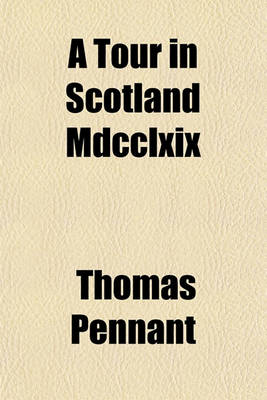Cambridge Library Collection - British & Irish History, 17th & 18th Centuries
6 total works
In this 1782 travelogue, naturalist Thomas Pennant (1726-98) immortalised the local history, churches, homes and antiquities he encountered on his yearly trip to London. In The Literary Life of the Late Thomas Pennant, Esq. (1793), also reissued in this series, Pennant writes that he often stayed several days or more in each village to learn about its history. He hoped to rid the route of the 'calumny' of 'dulness', and although he was more interested in antiquities than contemporary innovations, he describes the impact of some developments such as a new canal system. In addition to describing places and artefacts which have since been altered or lost, Pennant's writing unconsciously reveals the workings of his thorough mind, with its seemingly tireless capacity for observation. Featuring twenty-two engravings, this book contains a full account of Pennant's 1780 journey, as well as the description of an alternative route beginning in Northamptonshire.
Thomas Pennant (1726-98) is remembered for his work in bringing natural history to popular attention and for his engaging travel writing. With a number of fine engravings, this work, first published in 1771 and reissued here in its second edition of 1772, is typical of Pennant's output. More than a mere travelogue, it recounts his tour - via Tayside, Inverness, Wick and Fort William - of the Scottish Highlands, then largely unknown to outsiders but of notable interest to students of natural history. The volume is of particular significance for its meticulous descriptions of significant locations, buildings and wildlife, revealing Pennant's thorough mind and tireless capacity for observation, and also for its methodology: Pennant drew on local knowledge gathered by circulating queries in advance (these are included as an appendix). Several of Pennant's other works, including his Tour in Wales, are also reissued in the Cambridge Library Collection.
Originally published in 1776, Thomas Pennant's "Tour in Scotland and 18th century. Written after his five month journey through mainland Scotland and the Western Isles in the summer of 1772, Pennant paints a vivid picture of Scotland during the last quarter of the 18th century. Pennant had an eye for detail, and the account of his journeys includes a wealth of material regarding the physical features of the landscape, architectural details of buildings and the historical associations and local customs of the places he visited. He also writes of the people he met and the places he stayed, thus adding a human dimension to his travelogue. Within this text, Pennant also writes of his travels in the north of England, including descriptions of the medieval towns of Chester and Durham and the magnificent landscape of the Lake District.the Western Isles " is one of the major pieces of travel writing from the
Antiquary, zoologist and traveller, Thomas Pennant (1726-98) is remembered for his work in bringing natural history to popular attention and for his engaging writing about the journeys he made. Lavishly illustrated by Moses Griffith with fine engravings of the stunning scenery, buildings and artefacts, this work appeared in two volumes between 1778 and 1781. More than a mere travelogue, this tour of his native country is full of delightful vignettes and historical background. The descriptions of locations and buildings reveal Pennant's thorough mind and tireless capacity for observation. Several of Pennant's other works, including his Tour in Scotland (second edition, 1772), are also reissued in the Cambridge Library Collection. Volume 1 begins in Pennant's birthplace, Downing in Flintshire, and follows a route around North Wales, making 'a complete tour of the tamer parts of our country'. The places visited include Chester, Oswestry, Llangollen, Mold and Caerwys.
A Tour in Wales, MDCCLXXIII: Volume 2, The Journey to Snowdon
by Thomas Pennant
Published 22 May 2014
Antiquary, zoologist and traveller, Thomas Pennant (1726-98) is remembered for his work in bringing natural history to popular attention and for his engaging writing about the journeys he made. Lavishly illustrated by Moses Griffith with fine engravings of the stunning scenery, buildings and artefacts, this work appeared in two volumes between 1778 and 1781. More than a mere travelogue, this tour of his native country is full of delightful vignettes and historical background. The descriptions of locations and buildings reveal Pennant's thorough mind and tireless capacity for observation. Several of Pennant's other works, including his Tour in Scotland (second edition, 1772), are also reissued in the Cambridge Library Collection. Volume 2 follows a route around the area of Snowdonia, the Llyn Peninsula, Caernarfon, Anglesey and the north-east coast. The latter part of the volume traces a journey from Downing in Flintshire to Shrewsbury via Montgomery.
Antiquary, zoologist and traveller, Thomas Pennant (1726-98) is remembered for his work in bringing natural history to popular attention and for his engaging writing about the journeys he made. Lavishly illustrated by Moses Griffith with fine engravings of the stunning scenery, buildings and artefacts, this work appeared in two volumes between 1778 and 1781. More than a mere travelogue, this tour of his native country is full of delightful vignettes and historical background. The descriptions of locations and buildings reveal Pennant's thorough mind and tireless capacity for observation. Several of Pennant's other works, including his Tour in Scotland (second edition, 1772), are also reissued in the Cambridge Library Collection. Volume 1 follows a route around North Wales. The places visited include Chester, Oswestry, Llangollen, Mold and Caerwys. Volume 2 explores the area of Snowdonia, the Llyn Peninsula, Caernarfon, Anglesey and the north-east coast.



